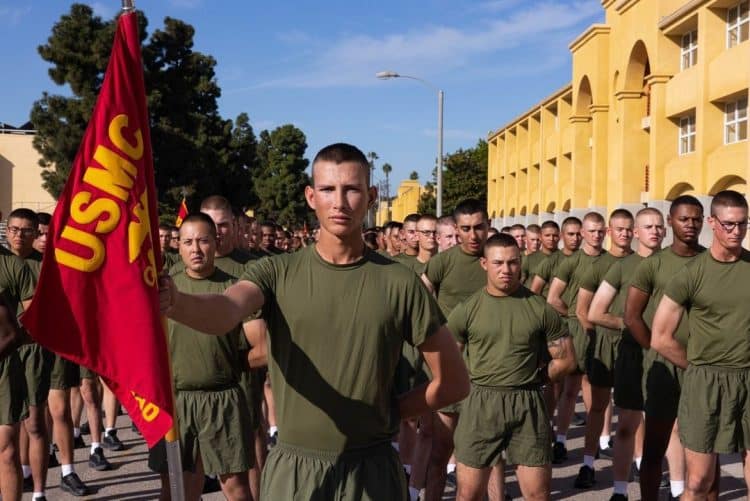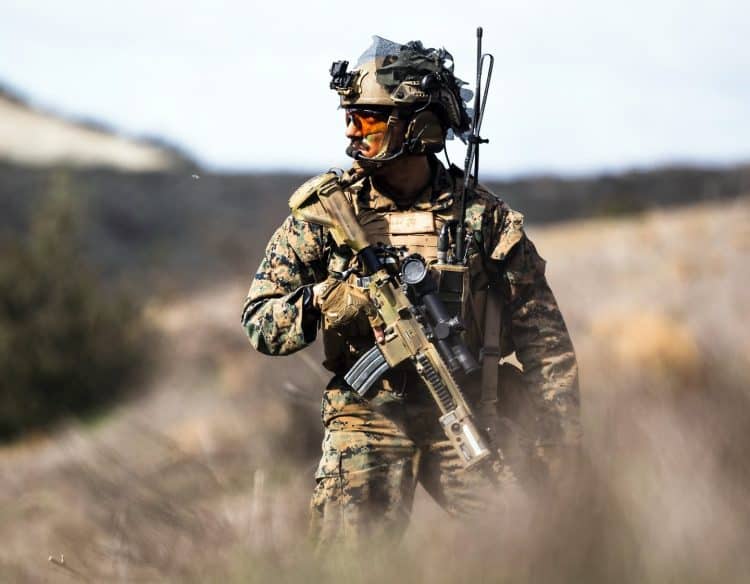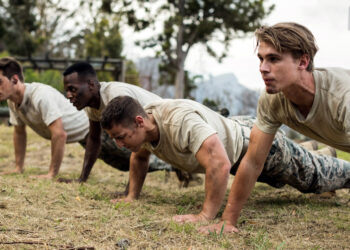As a British Royal Marine, I had the pleasure of working with the USMC (United States Marine Corps) on several occasions. I was always impressed by their friendliness, hospitality, and utter professionalism.
Every member of the USMC I ever met was incredibly proud to be a Marine, and there was a real sense of brotherhood with Marines from other countries. Needless to say, I was also happy we were on the same side – American Marines are TOUGH!
Like all elite armed forces, the Marines take physical training very seriously. After all, it’s a job where your life and the life of your colleagues can depend on your fitness. Just getting into the Marines requires above-average fitness, and that fitness is tested hard and often during training and on deployment.
In this article, we’re going to look at the fitness requirements to be a Marine and provide you with a training plan to become Marine fit.
USMC Physical Fitness Requirements
While you don’t need to be Navy SEAL fit to get into the USMC, you do need to be fit enough to complete a barrage of basic strength and cardiovascular tests and assessments.

All Marines are expected to be able to pass the following:
Level Up Your Fitness: Join our 💪 strong community in Fitness Volt Newsletter. Get daily inspiration, expert-backed workouts, nutrition tips, the latest in strength sports, and the support you need to reach your goals. Subscribe for free!
Initial Strength Test (IST)
Even before entering recruit training, USMC candidates must have a reasonable level of muscular strength, fitness, and endurance. The IST is designed to separate the strong from the weak. Unfortunately, those that fail the IST cannot progress onto basic Marine training.
Pull-ups/push-ups
- Male: 3 pull-ups or 34 push-ups (2:00 time limit)
- Female: 1 pull-up or 15 push-ups (2:00 time limit)
Plank/crunches
- Male & Female: 40-second plank or 44 crunches
Run
- Male: 1.5 mile run in 13:30
- Female: 1.5 mile run in 15:00
Marine Corps Physical Fitness Test (PFT)

Members of the USMC are expected to maintain a good fitness level throughout their careers. This ensures they are always combat-ready. The PFT is done at least annually and often more frequently. Any ranks that fail the PFT are in danger of being discharged.
This test consists of three disciplines:
- Pull-ups or push-ups
- Timed crunches or plank
- Timed three-mile run
It’s beyond the scope of this article to list all the standards for each test, but a 21 to 25-year-old male Marine should be able to do the following:
- 5 to 23 pull-ups
- 40 to 87 push-ups
- 70 to 110 crunches
- Run three miles in 18.00 to 27.40 minutes
The standard required for a pass depends on age and gender, but all Marines are expected to exceed the minimum level by a considerable margin. Just scraping by is NOT the USMC way!
Combat Fitness Test (CFT)
The CFT is designed to test the types of fitness Marines need to demonstrate during combat situations. It has three parts, with each one assessing a different aspect of functional fitness.

The three tests are:
Movement to contact: This is an 880-yard timed sprint designed to simulate the demands of running toward an enemy force.
Ammunition lift: Designed to test a Marine’s upper body endurance, this test involves lifting a 30-pound ammunition box overhead as many times as possible in two minutes.
Maneuver under fire (MUF): The final test is a 300-yard assault course that comprises several battle-like challenges. These include sprints, agility course, high crawl, low crawl, body drag, fireman carry, ammo carry, push-ups, and grenade throw.
As with all Marine fitness tests, minimum and maximum standards depend on age and gender.
However, a 21 to 25-year-old male Marine should be able to:
- Complete the 880-yard sprint in 2.38 – 3.45 minutes
- Lift the 30-pound ammo box 67 – 115 times in two minutes
- Complete the MUF course in 2.45 – 3.18 minutes
You can read more about these tests at the official USMC website.
Marine Workout Plan
Whether you are thinking of joining the Marines or just want to be Marine-fit, this program will develop the strength and conditioning you need to succeed. Each day focuses on a different aspect of your fitness, so that you’ll be ready for whatever life throws at you.
Note, this is NOT an official Marine workout plan but is inspired by the type of physical training that Marines (British and American) do on a regular basis.
Monday – Cadence Run
Marines do much of their running in groups and usually to a cadence set by their instructor. Cadence runs build cardiovascular fitness, lower body endurance, and corps spirit and vary from two to four miles or more.
For your workouts, start with a manageable distance, e.g., 1.5 miles, and increase by 10% per week as you get fitter.
Your running tempo should be a steady 150 steps per minute. You can find USMC running cadences on Spotify and YouTube:
Tuesday – PFT Maximums
Today’s workout is all about improving your USMC PFT score. While you can pass the PFT with a relatively low number of reps, if you want to be taken seriously as a candidate for promotion, you need to be able to crush the minimum scores by a considerable margin.
Warm up with a few minutes of light jogging, followed by dynamic mobility and flexibility exercises for your major muscles and joints.
Then, when you are ready, perform the following:
- Pull-ups – maximum reps
- Rest 1 minute
- Push-ups – maximum reps
- Rest 1 minute
- Crunches – maximum reps
- Rest 1 minute
- Complete this circuit three times
Finish off your workout with five sets of 220-yard sprints. Go pretty easy on the first 1-2 efforts and then all out on the final three. Rest three minutes between each sprint.
Wednesday – Rucking
Rucking is what Marines call walking while carrying a heavy backpack or rucksack. Marines ruck while on patrol or just getting their equipment from point A to B. Rucking also builds fitness, endurance, and lower body strength. But, because it’s low impact, it is often more joint-friendly than running, which is good news if you are a little on the heavy side.
For your first ruck, load up a backpack or a weighted vest with about 15-20 percent of your body weight. Then, head out and walk briskly for 30-40 minutes. Increase the weight and/or the distance over the coming weeks.
Thursday – Strength Training
Marines are generally stronger and more muscular than the average civilian. While high-rep calisthenics is part of the reason for this, many Marines lift weights in their spare time, training for increased muscle size and strength.
You don’t need to spend hours in the gym to build the strength you need to be an effective Marine. In fact, one solid workout a week should be sufficient, especially considering the other types of training in your weekly schedule.
Warm up thoroughly and then perform the following routine. Try to increase your weights from one week to the next to ensure you keep getting stronger. However, never sacrifice good form for more weight on the bar or more reps. Poor form can get you injured!
| # | Exercise | Sets | Reps | Recovery |
| 1 | Deadlift | 2-4 | 8-15 | 1-2 minutes |
| 2 | Bench press | 2-4 | 8-15 | 1-2 minutes |
| 3 | Lat pulldown | 2-4 | 8-15 | 1-2 minutes |
| 4 | Leg press | 2-4 | 8-15 | 1-2 minutes |
| 5 | Military press | 2-4 | 8-15 | 1-2 minutes |
| 6 | Seated row | 2-4 | 8-15 | 1-2 minutes |
| 7 | Cable crunch | 2-4 | 8-15 | 1-2 minutes |
| 8 | Dumbbell side bend | 2-4 | 8-15 | 1-2 minutes |
Finisher: After completing the program, do one of the following finishers as fast as possible…
- Run 1.5 miles
- Row 2,000 meters
- Do 100 burpees
- Do 100 swings with a 16-24kg kettlebell
Alternatively, choose a finisher from this article.
Friday – Fartlek Run
Fartlek is Swedish for speed play. With fartlek, you run at a range of speeds to challenge and develop all aspects of your cardiovascular fitness. Fartlek workouts are not programmed in advance. Instead, you make them up as you’re running.
For example, you might jog for five minutes, pick up the pace and maintain a fast speed for three minutes, walk for two minutes, sprint up a hill for one minute, jog for five minutes to recover, and then run at your usual pace for three minutes.
Keep changing pace for the duration of your workout. Finish off with a few minutes of easy jogging or walking to cool down, and you’re done.
So, for today’s workout, head out and do a 20 to 40-minute Fartlek run. If possible, make this a trail run, which is easier on your joints than running on tarmac or pavement. Also, seek out hills to make your workout more challenging.
Level Up Your Fitness: Join our 💪 strong community in Fitness Volt Newsletter. Get daily inspiration, expert-backed workouts, nutrition tips, the latest in strength sports, and the support you need to reach your goals. Subscribe for free!
Already fit USMC wannabes include plenty of long, fast bursts in their fartlek workout. In contrast, less fit individuals can include easier-paced running and walking. Modify the workout to suit your needs and abilities.

Saturday – Cindy
Cindy is a CrossFit benchmark workout. It is perfect for Marines-in-training as it involves two key exercises – push-ups and pull-ups – and challenges your endurance and fitness. And, maybe best of all, it’s over and done in 20 minutes, leaving the rest of your Saturday free for rest and recuperation, or R ‘n’ R in Marine-speak.
So, for this workout, complete as many laps as possible in 20 minutes of:
- 5 pull-ups
- 10 push-ups
- 15 air-squats
Rest when you need to but remember the clock is always ticking. Finish your Cindy workout with three laps of the following core-centric circuit:
- Plank 30 seconds
- Side plank (left) 30 seconds
- Side plank (right) 30 seconds
- Flutter kicks 30 seconds
- Rest one minute
Sunday – Rest Day
Even Marines usually don’t work out seven days a week, and rest is essential to any training program. That said, you should try and remain active on your day off, as keeping moving will enhance recovery and stop you from stiffening up.
Good activities for today include:
- Hiking
- Mountain biking
- Playing ultimate freebie or touch football
- Basketball
- Swimming
- Yoga/stretching
Try not to turn these activities into a workout. Instead, do them in a non-military leisurely fashion instead of with maximal intensity. So, play, don’t train!
Marine Workout Plan – FAQs
Do you have a question about our Marine workout plan? No problem, because we’ve got the answers!
1. What is the best time to do the workouts in the Marine Workout Plan?
The best time to work out is whenever you can do it consistently.
Some people will tell you that the best time to train for fat loss is in the morning when your stomach is empty. Others will say that the best time to lift weights is in the evening when your core temperature is higher and your anabolic hormones peak.
And while both these points of view may be valid, neither really matters enough to make or break your progress.
However, missing workouts WILL affect your results, so choose a time to train that works for you. That could be early in the morning before work or school, during your lunch break, after work, or late at night.
It really doesn’t matter when you train, so long as you do it.
2. What diet should I follow during this plan?
It’s beyond the scope of this article to tell you what and when to eat. However, you’ll get better results from this workout plan if you eat healthily and drink plenty of water. Healthy food puts back into your body what intense training takes out, and your body will function much more efficiently if you provide it with the right nutrients.
If you are unsure what healthy eating entails, check out this simple guide to creating the perfect diet in six weeks.
3. Can I move or change the workouts?
Feel free to make changes to this plan if necessary. For example, if you can’t do the cadence run on Monday, move it to later in the week. However, you should avoid changing the exercises or the workouts more than necessary as they’ve been designed to achieve a specific outcome, i.e., get you Marine-fit.
For example, replacing pull-ups with biceps curls won’t do much for your PFT score, nor will doing bench presses instead of push-ups.
So, make small changes if needed, but do your best to stay true to the spirit of the plan and workouts.
4. Will this workout plan help me lose weight?
Diet is more important for weight loss (or fat burning) than your workout. However, providing you eat a little less and create a calorie deficit, your workouts will contribute to your caloric shortfall, so your body burns more fat for fuel.
However, if your diet contains too many calories, even long, daily workouts won’t help you lose weight.
So, yes, this workout plan could help you lose weight, but only if your caloric intake is below your Total Daily Energy Expenditure, known as your TDEE, for short.
5. Will this workout plan help me build muscle?
Your body builds muscle according to the demands placed on it. If the workouts in this plan are sufficiently intense that your body determines more muscle mass is needed, muscle growth will occur. For example, if doing pull-ups and push-ups are adequately demanding.
However, if there is no such demand, then your body has no need to increase muscle size, and growth will not happen.
If muscle growth is your goal, you’ll probably get better, more reliable results by following a hypertrophy-specific bodybuilding program. Alternatively, you can write your own bodybuilding workout.
6. Will supplements be helpful during this workout plan?
While you don’t have to use supplements to build muscle and get stronger, some products may be helpful. For example, they may help you train harder or longer, recover better between workouts, or improve your general health.
However, their effect is relatively small.
Good options include:
- BCAAs and EAAs – for recovery and muscle growth
- Creatine – for energy and muscle building
- Pre-workouts – for fast-acting energy and better workouts
- Protein powder – for recovery and muscle growth
- ZMA – for better sleep and hormone optimization
Remember, though, that even the best supplements won’t help if you aren’t training hard, eating right, and getting plenty of sleep.
7. How can I make sure I recover properly between workouts?
High-frequency training programs like this Marine workout plan take a lot out of your body. For your body to adapt and become fitter and stronger, you need to rest and recover. But how is this possible when you’re training six days per week?
The good news is that you CAN recover from high-frequency training. You must a) undulate the intensity of each workout and b) increase the difficulty and duration of your workouts over several weeks and months.
In addition, you’ll recover faster and more completely by:
- Getting 7-9 hours of sleep per night.
- Consuming fast-acting carbohydrates shortly after training.
- Stretching and cooling down after your workouts.
- Being lightly active between workouts.
- Foam rolling your muscles or getting regular massages.
Read more about maximizing recovery here.
8. How long should I follow this program?
There are three main reasons to change your workout program:
- Your progress has stalled.
- You aren’t enjoying it.
- Your training goals have changed.
So, providing the Marine workout plan is producing the results you want, the training is enjoyable, and you still want to build cardiovascular fitness, endurance, and strength, you should continue with the program.
However, to keep progressing, you MUST work a little harder from one week to the next. For example, you can run further or faster, do more push-ups, or lift heavier weights. Doing the same workout at the same level over and over won’t make you fitter or stronger.
Closing Thoughts
Training like a Marine is not for everyone. Marines are fitness generalists and need to have a good level of cardiovascular fitness, strength, and endurance. As such, their training combines running with calisthenics and weights.
Doing a little bit of everything means that Marines are rarely super-fit or ultra-strong and muscular. Instead, they’re balanced all-rounders ready for almost anything life throws at them.
If you want to lift weights like a powerlifter, you must train like a powerlifter. Similarly, if you want big muscles like a bodybuilder, then that’s how you should train.
But, if you want to be fit for the far-reaching demands of combat, then this Marine workout plan could be for you.








